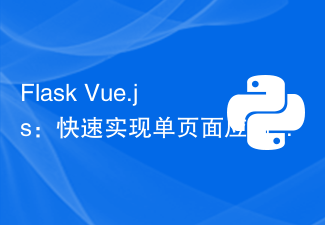How to set up the login function in vuejs: 1. Write html files; 2. Submit data to the background through the "vue-resource.js" library; 3. Receive data through "public class UserController {...}" That’s it.

The operating environment of this article: Windows 7 system, vue version 2.9.6, DELL G3 computer.
How to set up login in vuejs?
Vue.js implements the login function
Write html and submit data to the background through the vue-resource.js library
<!DOCTYPE html>
<html>
<head>
<meta charset="UTF-8">
<title>用户注册</title>
<link href="bootstrap-4.3.1-dist/css/bootstrap.min.css" rel="stylesheet">
<script src="js/jquery.js"></script>
<script src="bootstrap-4.3.1-dist/js/bootstrap.js"></script>
<script src="js/vue.js"></script>
<!-- 异步提交的库 -->
<script src="js/vue-resource.min.js"></script>
<style>
.container {
margin-top: 15%;
width: 35%;
}
.btn-primary {
background-color: #337ab7;
border-color: #337ab7;
}
.form-control {
margin-bottom: 4px;
}
</style>
</head>
<body>
<div>
<!--<div id="demo" v-show="show" class="alert alert-success">
<span v-if="alert_tips">成功!很好地完成了提交。</span>
</div>-->
<form id="form">
<div>
<!--<h2 id="登录">登录</h2>-->
<!--将label标签隐藏 -->
<label for="exampleInputUsername">用户名</label>
<!-- 会忽略所有表单元素的value、checked、selected特性的初始值,而总是将Vue实例的数据作为数据来源 -->
<input type="text" v-model="formObj.username" id="exampleInputUsername" name="username"
placeholder="用户名">
<label for="exampleInputUsername">密码</label>
<input type="password" v-model="formObj.password" id="exampleInputPassword"
name="password"
placeholder="密码">
<div>
<label>
<!--<input type="checkbox">
记住密码-->
</label>
</div>
<button class="btn btn-lg btn-primary btn-block" onclick="ajaxRegister()" type="button">注册
</button>
</div>
</form>
</div>
</body>
<script>
function ajaxRegister() {
//Vue的异步Get请求
/*Vue.http.get("/test").then(function (res) {
console.log(res.bodyText);
}, function (res) {
console.log(res.status);
});*/
var param = new FormData(document.getElementById("form"));
// param = convert_FormData_to_json(param);
console.log(param);
Vue.http.post("/login", param).then(function (res) {
console.log(res.bodyText);
console.log("登录成功");
}, function (res) {
alert("登录失败");
});
return false;
}
</script>
</html>Receive in the background Data
@RestController
public class UserController {
@Autowired
private UserService userService;
//通过RequestBody实现与json交互
@RequestMapping(value = "/register", method = RequestMethod.POST)
//接收从客户端传过来的FormData()数据
@RequestMapping(value = "/login", method = RequestMethod.POST)
public String login(HttpServletRequest request) throws ParseException {
MultipartHttpServletRequest params = (MultipartHttpServletRequest) request;
// List<MultipartFile> files = ((MultipartHttpServletRequest) request).getFiles("file");
Map<String, String[]> parameterMap = params.getParameterMap();
//将Map<String,String[]>转成Map对象
Map map = GenUtils.toParameterMap(parameterMap);
//将Map对象生成为指定的Pojo对象
User user = GenUtils.mapGetObj(User.class, map);
//
user = userService.selectByUser(user);
//
JSONObject jsonObject = JSONObject.fromObject(user);
return jsonObject + "";
}
}Recommendation: "The latest 5 vue.js video tutorial selections"
The above is the detailed content of How to set up login in vuejs. For more information, please follow other related articles on the PHP Chinese website!
 VUE3基础教程:使用Vue.js插件封装图片上传组件Jun 15, 2023 pm 11:07 PM
VUE3基础教程:使用Vue.js插件封装图片上传组件Jun 15, 2023 pm 11:07 PMVUE3基础教程:使用Vue.js插件封装图片上传组件Vue.js是一款流行的前端框架,它使开发者可以用更少的代码创建更高效、灵活的应用程序。尤其是在Vue.js3发布之后,它的优化和改进使得更多的开发者倾向于使用它。这篇文章将介绍如何使用Vue.js3来封装一个图片上传组件插件。在开始之前,需要先确保已经安装了Vue.js和VueCLI。如果尚未安装
 VUE3快速入门:使用Vue.js指令实现选项卡切换Jun 15, 2023 pm 11:45 PM
VUE3快速入门:使用Vue.js指令实现选项卡切换Jun 15, 2023 pm 11:45 PM本文旨在帮助初学者快速入手Vue.js3,实现简单的选项卡切换效果。Vue.js是一个流行的JavaScript框架,可用于构建可重用的组件、轻松管理应用程序的状态和处理用户界面的交互操作。Vue.js3是该框架的最新版本,相较于之前的版本变动较大,但基本原理并未改变。在本文中,我们将使用Vue.js指令实现选项卡切换效果,目的是让读者熟悉Vue.js的
 Flask + Vue.js:快速实现单页面应用Jun 17, 2023 am 09:06 AM
Flask + Vue.js:快速实现单页面应用Jun 17, 2023 am 09:06 AM随着移动互联网和Web技术的迅速发展,越来越多的应用需要提供流畅、快速的用户体验。传统的多页面应用已经无法满足这些需求,而单页面应用(SPA)则成为了解决方案之一。那么,如何快速实现单页面应用呢?本文将介绍如何利用Flask和Vue.js来构建SPA。Flask是一个使用Python语言编写的轻量级Web应用框架,它的优点是灵活、易扩
 VUE3基础教程:使用Vue.js插件封装日历组件Jun 15, 2023 pm 09:09 PM
VUE3基础教程:使用Vue.js插件封装日历组件Jun 15, 2023 pm 09:09 PMVue.js是现代化的前端JavaScript框架之一,它提供了一套完整的工具来构建交互式用户界面。在Vue.js的生态系统中,有各种各样的插件和组件,可以大大简化我们的开发流程。在本篇文章中,我们将介绍如何使用Vue.js插件封装一个日历组件,以方便我们在Vue.js项目中快速使用。Vue.js插件Vue.js插件可以扩展Vue.js的功能。它们可以添加全
 Vue.js实现登录验证的完整指南(API、JWT、axios)Jun 09, 2023 pm 04:04 PM
Vue.js实现登录验证的完整指南(API、JWT、axios)Jun 09, 2023 pm 04:04 PMVue.js是一种流行的JavaScript框架,用于构建动态Web应用程序。实现用户登录验证是开发Web应用程序的必要部分之一。本文将介绍使用Vue.js、API、JWT和axios实现登录验证的完整指南。创建Vue.js应用程序首先,我们需要创建一个新的Vue.js应用程序。我们可以使用VueCLI或手动创建一个Vue.js应用程序。安装axiosax
 VUE3开发入门教程:使用Vue.js组件封装chart图表Jun 15, 2023 pm 10:29 PM
VUE3开发入门教程:使用Vue.js组件封装chart图表Jun 15, 2023 pm 10:29 PM随着大数据时代的到来,数据可视化已经成为了现如今的趋势之一。在Web前端开发的过程中,如何使用Vue.js进行数据可视化处理,成为了许多前端开发者所关注的问题。本文将会介绍如何使用Vue.js组件,封装基于chart.js库的图表。1.了解chart.jsChart.js是一款基于HTML5CanvasElement的简单易用、跨平台的开源图表库,我们可
 VUE3基础教程:使用Vue.js自定义事件Jun 15, 2023 pm 09:43 PM
VUE3基础教程:使用Vue.js自定义事件Jun 15, 2023 pm 09:43 PMVue.js是一款流行的JavaScript框架,它提供了很多方便的特性,所以它在开发Web应用程序时非常有用。Vue.js中的自定义事件系统使其更加灵活,并且可以通过组件事件触发和处理来实现更好的代码重用性。在本文中,我们将讨论如何使用Vue.js的自定义事件。Vue.js中自定义事件的基础在Vue.js中,我们可以通过v-on指令来监听DOM事件。例如,
 使用Python与Vue.js开发实时同步的Web应用程序Jun 17, 2023 am 08:28 AM
使用Python与Vue.js开发实时同步的Web应用程序Jun 17, 2023 am 08:28 AM随着Web应用程序的普及和用户体验的要求不断提高,实时同步已经成为了现代Web应用程序不可或缺的功能。在本文中,我们将介绍如何使用Python和Vue.js开发实时同步的Web应用程序。为了实现实时同步的功能,我们需要使用一些现代化的Web技术,其中包括WebSocket、异步编程和前端框架。以下是本文中将用到的技术栈:Python3.6+FlaskFla


Hot AI Tools

Undresser.AI Undress
AI-powered app for creating realistic nude photos

AI Clothes Remover
Online AI tool for removing clothes from photos.

Undress AI Tool
Undress images for free

Clothoff.io
AI clothes remover

AI Hentai Generator
Generate AI Hentai for free.

Hot Article

Hot Tools

Atom editor mac version download
The most popular open source editor

Dreamweaver CS6
Visual web development tools

Safe Exam Browser
Safe Exam Browser is a secure browser environment for taking online exams securely. This software turns any computer into a secure workstation. It controls access to any utility and prevents students from using unauthorized resources.

MantisBT
Mantis is an easy-to-deploy web-based defect tracking tool designed to aid in product defect tracking. It requires PHP, MySQL and a web server. Check out our demo and hosting services.

Zend Studio 13.0.1
Powerful PHP integrated development environment







